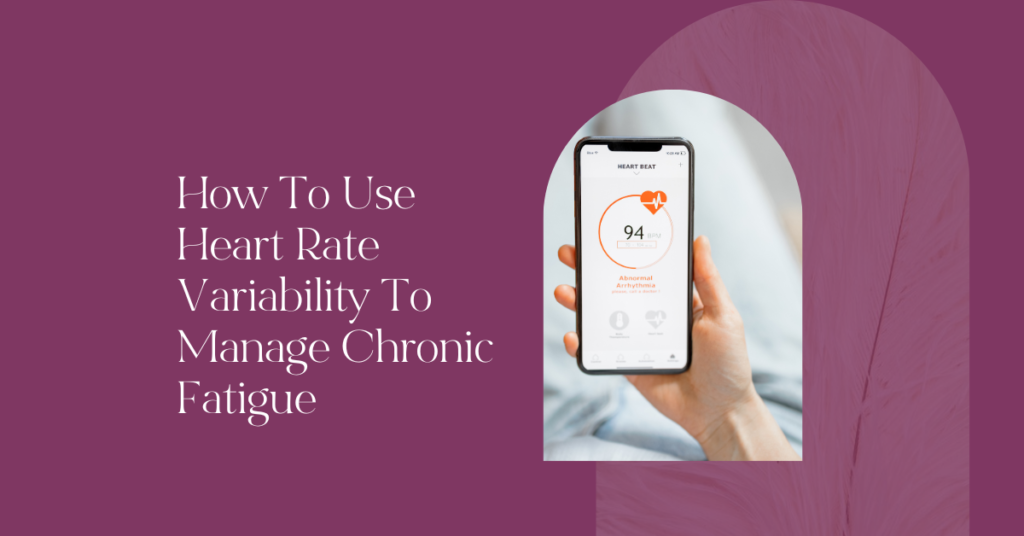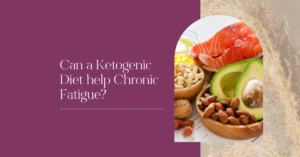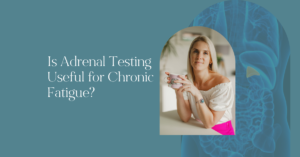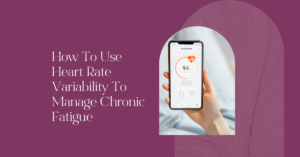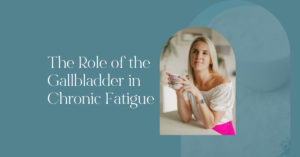Many people with Chronic Fatigue conditions like CFS/ME and Long Covid are turning towards technology, like Heart Rate Variability, to help them better manage their health, their nervous systems and support their recoveries.
Heart Rate Variability (HRV) is a biological marker that you can now measure using a watch or an app on your smartphone linked to a wearable device. If you can understand HRV, you potentially have valuable insight into the state of your autonomic nervous system and day to day fluctuating levels of resilience and capacity.
However, when it comes to harnessing the power of HRV in chronic illness generally and chronic fatigue more specifically, there is both an art and a science. Being able to understand and interpret data in a way that is meaningful to the individual is what can make or break the impact of the technology.
In this blog we will cover both; What is HRV and how can it be measured? And, how do we interpret the data in the nuance and complexity of a chronic fatigue landscape? What can be done to use this information to our advantage?
What is Heart Rate Variability?
Heart Rate Variability (HRV) refers to the variation of time between each heart beat. The heart does not beat like a metronome, instead some heart beats are closer together and some are further apart. For example, if your heart beats at 60 beats per second, this might mean some beats happen every 0.8 seconds, some at 1.2 seconds, some every 0.9 seconds, but the average is every second, which equals 60 beats per minute.
HRV is a natural phenomenon that occurs due to the dynamic interplay of the sympathetic and parasympathetic branches of the autonomic nervous system (ANS) regulating the heart rate. Therefore, the ability to monitor HRV, gives insight into the balance of these two branches of the nervous system.
More variability between heart beats (i.e. a less metronomic heartbeat), is indicative of higher parasympathetic tone in the nervous system. Less variability, a more metronomic heartbeat, is indicative of higher sympathetic tone in the nervous system and the activation of greater fight or flight responses.
How is Heart Rate Variability Useful in Chronic Fatigue?
Given the popularity of understanding the nervous system in the context of chronic illness, many people make use of HRV technology to gain insight into the state of their nervous system so that they can support and guide their systems away from too much sympathetic tone and towards more restful and restorative parasympathetic tone.
Here’s how HRV can be useful in the context of chronic fatigue:
Autonomic Nervous System (ANS) Dysregulation
Chronic fatigue often involves dysregulation of the autonomic nervous system (ANS), with an imbalance between the sympathetic (fight-or-flight) and parasympathetic (rest and digest) branches. HRV reflects this balance, and monitoring it can provide insights into ANS activity. In CFS, individuals may exhibit lower HRV, suggesting a dominance of sympathetic activity, which may contribute to fatigue.
Stress Assessment
Chronic stress is a common factor in chronic fatigue. HRV can serve as a non-invasive and objective marker of stress levels. Individuals experiencing chronic fatigue often have altered stress responses, and HRV monitoring can identify periods of heightened stress. By recognizing these patterns, individuals can implement stress management techniques to improve overall well-being.
Exercise Prescription
Physical activity is an important aspect of managing chronic fatigue, but it’s crucial to find the right balance. HRV can help tailor exercise programs by indicating the body’s readiness for physical exertion. Monitoring HRV can guide individuals in choosing appropriate exercise intensity and volume, preventing overtraining and fatigue exacerbation.
Sleep Quality
Sleep disturbances are common in chronic fatigue. HRV can be used to assess sleep quality, as disruptions in the sleep-wake cycle can impact autonomic balance. Monitoring HRV during different sleep stages can provide insights into the effectiveness of sleep, allowing for adjustments to improve restorative sleep.
Biofeedback and Relaxation Techniques
HRV biofeedback involves training individuals to regulate their ANS activity consciously. This can be particularly beneficial for those with chronic fatigue, as it empowers individuals to modulate their physiological responses. Techniques such as deep breathing and meditation, guided by HRV biofeedback, may help restore balance to the autonomic nervous system.
Early Warning Signs
Changes in HRV patterns may serve as early warning signs of exacerbation of fatigue or other symptoms associated with chronic fatigue. Regular HRV monitoring can enable individuals to identify patterns and make proactive adjustments to their lifestyle, potentially preventing worsening fatigue episodes.
How Can We Measure HRV?
Heart Rate Variability (HRV) can be measured using various methods, ranging from simple manual techniques to advanced technologies. Most people in the Chronic Illness Community are using Mobile Apps and Wearable Devices to measure their HRV. I do not have personal experience with all of them, but here are some of the popular options:
- Apple Watch
- Garmin Watch*
- Oura Ring*
- Whoop Strap
- Elite HRV app with Chest Strap Monitor*
Heart Rate Variability (HRV) is typically measured in milliseconds (ms) or as the time between successive heartbeats.
When it comes to collecting and comparing data, it is best to compare like with like. In other words, if you measure your HRV on an Oura Ring, then you should always measure it on an Oura Ring for comparison purposes.
* I have experience with these products and you can read a bit more about my experiences with them in this blog post.
What Is Optimal Heart Rate Variability?
There is no optimal HRV per se, rather there is what is optimal for you. For example, you may find that your average HRV is 35ms but someone else has an average of 45ms. You know when your HRV drops to 25ms that you feel worse and when it goes a little higher, e.g. 42ms, you feel at your best. For someone else this may be completely different so the trick to using HRV data to optimise your selfcare is to understand how your body works.
How Do You Interpret Your HRV Data?
Interpreting your HRV data involves both art and science. Generally speaking a higher HRV can be a sign of more coherence in the nervous system and greater resilience to manage stress.
A lower HRV may be indicative of more stress and greater sympathetic activity of the autonomic nervous system encouraging more rest, restoration and active recovery.
From a chronic fatigue recovery perspective, days when HRV is higher you may feel that you want to do a little bit more. Days when HRV is lower, you may feel that you want to pair back, add in more rest or restorative practices. Therefore, having an understanding of how resilient you are day to day can help with decision making when it comes to planning your day, activity levels and commitments.
Additionally, you can track changes in HRV over time to see what is more supportive for your body and what adds to the stress load.
Many devices will give you a monthly average HRV which can be useful to track progress as a whole. An increase in your monthly average might mean:
- There were more good days than bad days
- You were able to do more without experiencing more stress on your nervous system
- Overall your capacity is expanding
Beware: Higher HRV is not always better
There is a phenomenon known as “Parasympathetic Overtraining Syndrome” (POS) whereby the nervous system enters a heightened parasympathetic state to “force” the body into recovery.
There is not a lot of information or research on POS and it was something that I stumbled on in my fatigue recovery journey while listening to a podcast with Dr Mike T Nelson on Dr Ruscio Radio.
When I discovered what it was, it made a lot of sense in the context of my fatigue recovery journey thus far. Whenever my resting heart rate was at its lowest and HRV was at its highest – which almost always coincided with my menstrual cycle – Oura would offer me an encouraging readiness score. Yet, this was often the time I felt worse, not better and my exercise tolerance was lower.
It is possible that the stress on menstruation, which can be energetically demanding, was placing extra strain on my body, asking me to rest. However, I would also experience a similar trend at other times of my cycle so this did also happen independently of menstruation.
What I learnt over time was that my ideal readiness was somewhere in between my lowest heart rate readings and my highest. This could also vary depending on where I was in my cycle so there was a different set of “rules” for the different phases of the cycle.
I arrived at this conclusion by using the data, correlating it with how I felt at the time and eventually working out what worked best for my body based on trial and error. The moral of the story here is that wearables are incredibly useful and we also want to learn to use them in conjunction with the body’s signals, not independently of them.
Can You Improve Your Heart Rate Variability?
Most people with Chronic Fatigue are seeking to improve their HRV as a marker of increased parasympathetic tone and improved resilience in the autonomic nervous system. However, we must remember that HRV will change as health changes and therefore, many of the things that support positive changes in HRV form the foundations of health and fatigue recovery that are often discussed on this blog and podcast. Here are some of them:
- Sleep
- Exercise
- Nutrition
- Mental and Emotional Stress
- Physical stress such as infections, toxins, blood sugar imbalances, alcohol, smoking and caffeine.
- Certain supplements may have a temporary effect on HRV
- Hormetic stressors such as fasting, cold water and heat stress may also impact HRV
The exact impact of these factors will vary from person to person based on their starting point and their own physiology. Here are some trends that I have personally observed:
Nutrition
Nutrition is something that I have personally and professionally noticed that can make a difference in HRV. The two main factors to consider are:
- Foods that support optimal blood sugar balance (which I have written about extensively here, here and here)
- Foods that are anti-inflammatory which, for most people will be unprocessed foods like meat, poultry, seafood, eggs, vegetables, nuts, seeds, fruits and whole grains. However, those who are sensitive to histamines, gluten, dairy or other foods, like nightshades or lectins, may notice that eating even small amounts impacts their HRV.
Anecdote: In my own journey I used an Oura Ring to track my HRV across the nighttime while I slept. If I had an evening meal that was destabilising for my body in some way, either by destabilising blood sugar or the overall inflammatory nature, I would notice a reduced HRV and, as a consequence, I would feel more groggy and brain foggy the next day. This taught me that if I want a treat, I need to do it earlier in the day so that my body can recover enough and my body can access better rest at night.
Food is a funny thing because, for many people, it holds a lot of emotional value. I often notice two types of trends with clients, those who are not very emotional about food. They follow the advice that they are given and feel better for it. The other type of client may feel deprived and struggle to be consistent enough with their diet to experience the therapeutic benefits of dietary change. Having objective data like blood sugar monitoring, or HRV in this case, can be helpful so that we can connect with how food is destabilising our physiology and how that impacts health and chronic fatigue recovery as a whole.
Supplements
I cannot speak for the long term impact of supplements on HRV personally but I have noticed changes in HRV in the short term after taking specific supplements. I can only share those that come from my direct experience which tend to be those that are antiinflammatory in nature (e.g. curcumin) or supportive for the nervous system (e.g. L-theanine and Lemon Balm).
The following are reported to potentially be beneficial for improving HRV due to their impact on heart health and adrenal function.
- Omega-3 Fatty Acids:
- Source: Fish oil, flaxseed oil, chia seeds.
- Benefits: Omega-3 fatty acids have anti-inflammatory properties and may positively influence heart health, potentially impacting HRV.
- Coenzyme Q10 (CoQ10):
- Source: Found in small amounts in various foods and available as a supplement.
- Benefits: CoQ10 is involved in the production of energy in cells and has antioxidant properties. Some studies suggest it may support cardiovascular health and improve HRV.
- Magnesium:
- Source: Nuts, seeds, leafy green vegetables, and magnesium supplements.
- Benefits: Magnesium plays a crucial role in muscle and nerve function, including the heart. Maintaining adequate magnesium levels may contribute to optimal heart function and potentially influence HRV.
- Rhodiola Rosea:
- Source: Adaptogenic herb available as a supplement.
- Benefits: Rhodiola rosea has been studied for its potential to reduce fatigue and stress, which could indirectly influence HRV by supporting overall well-being.
- Ashwagandha:
- Source: Adaptogenic herb available as a supplement.
- Benefits: Ashwagandha is known for its adaptogenic properties, helping the body cope with stress. Some studies suggest it may have a positive impact on HRV.
- Probiotics:
- Source: Fermented foods (yoghurt, kefir) and probiotic supplements.
- Benefits: Gut health has been linked to overall well-being, and there is emerging research on the potential connection between gut health, inflammation, and HRV.
- L-Carnitine:
- Source: Red meat, fish, poultry, and L-carnitine supplements.
- Benefits: L-Carnitine plays a role in energy metabolism and may have cardiovascular benefits, potentially influencing HRV.
- Vitamin D:
- Source: Sunlight, fatty fish, fortified foods, and vitamin D supplements.
- Benefits: Vitamin D is essential for overall health, and its deficiency has been associated with cardiovascular issues. Maintaining adequate vitamin D levels may positively affect HRV.
- Curcumin (Turmeric):
- Source: Turmeric spice and curcumin supplements.
- Benefits: Curcumin has anti-inflammatory properties and may contribute to cardiovascular health, potentially impacting HRV.
Alcohol
In the short term, consumption of alcohol may increase HRV. For example, you may have an alcoholic beverage and feel more relaxed. However, in the longer term, i.e. several hours after a drink, you may notice a disturbance in the autonomic nervous system and an increase sympathetic distress, reflected in a decreased HRV.
In healthy people, a single drink may not be enough to make a significant impact on the nervous system. In chronic illness, the nervous system may be much more sensitive and unstable and therefore the effects of alcohol are much more noticeable and destabilising.
I will state here what I tell all of my clients with regards to alcohol: There is no amount of alcohol that is good for your brain.
Given that many of the symptoms of chronic illness are rooted in neuroinflammation, if I could have it my way, none of my clients would drink at all or at least not until they had developed enough resilience in their nervous system to do so.
Exercise
Regular exercise has been consistently linked to an increase in Heart Rate Variability (HRV), indicating a positive impact on autonomic nervous system function. Engaging in aerobic and endurance exercises, such as jogging, cycling, or swimming, has been shown to enhance parasympathetic activity and reduce sympathetic dominance, resulting in greater HRV.
Exercise promotes cardiovascular health, improves heart rate regulation, and contributes to overall fitness. The adaptability of the cardiovascular system to the demands of physical activity is reflected in the variability of heartbeats, with higher HRV suggesting better autonomic balance.
However, in Chronic Illness, exercise can be a double edged sword. Therefore, any exercise needs to be appropriate for the tolerance level of the individual. Exercise which is too intense, goes on for too long or generally exceeds the individual’s capacity can be a source of inflammation and will suppress HRV.
This is where wearable devices can give helpful feedback because you can use your device the next day or overnight to assess the impact of your exercise choices on your body.
Anecdote: In my own journey I used a Garmin Watch day to day which had a stress score, which is inversely correlated with HRV. The lower the stress score, the higher the HRV and vice versa. I would typically find a gentle walk would lower my stress score and heart rate almost immediately after the exercise, whereas resistance training would increase the stress score and heart rate post-exertionally.
It was helpful to know that walking was actually good for my body and that the resistance training needed to be appropriately dosed. When I did too much, the stress score would stay elevated for hours, when I did the right amount, the stress score would return to a reasonable level within an hour or two or working out. Through trial and error I was able to find my edge and have the right dose of exercise to build capacity over time.
Hormetic Stressors: Heat Stress, Cold Stress and Fasting
Hormetic stressors refer to mild and beneficial stressors that, when applied in the right dosage, stimulate positive adaptive responses that lead to improved resilience and overall health. The concept is rooted in hormesis, a phenomenon where exposure to low or moderate levels of stress induces a positive response, while excessive stress can be harmful.
Exercise, previously discussed, is a hormetic stressor and other hormetic stressors include but are not limited to heat stress, cold stress and fasting. Hormetic stressors can have a positive impact on Heart Rate Variability (HRV) by promoting adaptive responses within the autonomic nervous system (ANS).
Hormetic stressors stimulate adaptive mechanisms that enhance the body’s ability to respond to stress, and this adaptability is often reflected in improved HRV.
Anecdote: I had a mixed response in my own journey to hormetic stressors. Cold water dipping, swimming and cold showers were something that I regularly did and still do. While submerged one may expect to experience an increase in sympathetic activation but afterwards there may be an increase in parasympathetic tone. For me this was observed by a reduction in heart rate and stress score (increased HRV) using my garmin watch.
At one point in my journey I would fast for 24 hours on an almost weekly basis. Although this is not recommended for everyone, it was beneficial for me. I would notice that on these longer fasts I would experience an increased HRV (as reflected by a low stress score in my Garmin Watch).
In summary, the acute benefits of cold exposure and fasting were evident to me, however, the overall long term benefits of these hormetic stressors on changing average HRV is difficult to quantify.
Heat exposure via the sauna was a more challenging experience. For a period of time, I could not tolerate sauna and it would often be a cause of PEM. However, I had missed an important point; Hormetic stressors are dose dependent. I was overdosing on sauna and in hindsight I needed to leave my ego behind and just use the sauna for 5 minutes at a time and build up gently. Heat has a very similar impact on the cardiovascular system to exercise and this is what can make it challenging from chronic illness generally and chronic fatigue specifically.
Summary and Conclusion
In summary, monitoring HRV can be a useful tool to gain insight into the autonomic nervous system for those managing chronic fatigue and other chronic illnesses. There are multiple devices available for different budgets and it might not be that one is better than the other, rather it is best to compare changes on the same device.
HRV data can be used to understand how the nervous system responds, both positively and negatively, to food, lifestyle and supplement choices and in doing so, help those managing their illness to refine their routines and choices to align with those that create a better sense of regulation day to day.
We all respond differently to different activities, foods and stressors and this modern technology enables us to personalise our self-care to the needs of our unique system.

